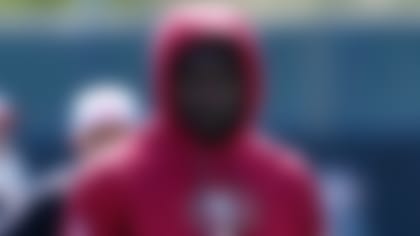In studying tape from the matchup, there are several aspects of the Giants' game plan that are sure to be incorporated by the Eagles' next few opponents. The first element is a heavy emphasis on the elimination of the big play. The Eagles have terrorized opponents with the long ball, and the Giants did a terrific job of keeping the ball in front of them. Safeties Deon Grant and Kenny Phillips played with plenty of depth (12-15 yards deep) in their two-deep zones and the cornerbacks made sure to settle underneath any post corner routes from the slot receivers. Michael Vick repeatedly found open windows in the middle of the field, but the Giants were content to let the Eagles drive the length of the field on an assortment of short and intermediate throws. By eliminating the quick strike, the Giants played the odds that a negative play (turnover, penalty or mental miscue) would end the drive and force the Eagles to punt or kick a field goal before they reach the end zone.
Of course, the key to executing a game plan that features soft-zone coverage is finding a way to contain Vick with a four-man rush. The Giants' depth along the defensive line allowed that strategy to work for most of the game. Osi Umenyiora, Chris Canty, Barry Cofield and Justin Tuck were able to generate enough push to keep Vick from fleeing the pocket through huge seams up front. Fewell sprinkled in some TEX stunts (defensive end and defensive tackle run a cross game with the end penetrating inside and the tackle working around the corner) to complement their conventional four-man rushes. The discipline of their defensive ends keyed the upfront pressure, as Tuck and Umenyiora didn't fly too far up the field to create an easy escape lane for Vick. This kept him confined to the pocket, and eventually resulted in a sack. Although he scrambled for 34 yards on 11 carries, Vick didn't hurt them with the game-changing runs.
When the Giants didn't sit back in their conservative zones, they attacked Vick with a host of Cover-0 pressures from the quarterback's strong side. These pressures, which remove a free safety from the middle of the field and attack the quarterback with one more defender than the number of blockers, forced Vick to identify the hot receiver quickly or take a wicked shot from the unblocked defender. This proved especially effective when the Giants won on early downs to create long-yardage situations. While the risky strategy exposed the corners to one-on-one coverage against DeSean Jackson and Jeremy Maclin, the decision to bring the blitz from Vick's left (his throwing side) made him escape the pocket to his right, which is a more difficult throw for a left-handed quarterback.
The Giants' tactics clearly disrupted the rhythm and timing of the Eagles' offense, but the strategy has serious flaws that can be exposed. The use of only four rushers with zone coverage behind it gives Vick a lot of time to identify open receivers down the field. Furthermore, it allows him to get the ball to Jackson and Maclin on the move in the middle of the field. While the duo didn't hurt the Giants with their ability to run after the catch, their speed and explosiveness could result in big gains as they elude defenders in space.
The use of all-out pressures also has the potential to backfire against the Vick-led Eagles. His ability to get out of jams could lead to huge plays if he gets past the initial wave of rushers. With corners locked in man-to-man, Vick could have a free run to the end zone against an undisciplined Cover-0 blitz.
If Vick's running skills don't act as an effective counter tactic, the Eagles have the potential to exploit the one-on-one coverage against Jackson and Maclin. Even though the Giants avoided being victimized by the duo, the Eagles will design a few quick-strike plays to take advantage of the all-out blitz in the future. Quick posts or quick outs from their slot receivers are an option, but the team could also incorporate some pre-determined rollouts to get Vick away from the pressure while buying him more time to push the ball down the field.
The Giants put some interesting concepts on tape for opponents to sample, but others will soon see if the risks are worth the rewards against an explosive offense.
Growing up fast in New England
Lost in the midst of the Patriots' run to the top of the AFC has been the dramatic improvement of their secondary. The much-maligned unit had been pegged as the defense's weakest link after the opening month of the season, but their performance against Peyton Manning illustrated the growth of the group.
The thought of surrendering 396 passing yards would make most teams cringe, but coach Bill Belichick should be pleased with his young secondary. While they allowed Manning to accumulate a ton of yardage on short and intermediate throws, they kept the Colts from connecting on deep and made him string together a series of completions on long drives to score. Belichick wanted to test Manning's patience and decision-making by using a variety of zone coverages from cleverly disguised looks.
With the Patriots opting to play coverage instead of applying pressure through blitzing, the onus fell directly on the shoulders of the inexperienced secondary to stay disciplined with their eyes and pass drops in coverage. The premise of playing zone is to force quarterbacks to settle for underneath routes or check downs with the hope of generating turnovers off tips or overthrows. Most quarterbacks aren't patient enough to repeatedly throw underneath the zone to put together a drive, and they eventually force the ball into a tight window looking for a bigger gain, which opens the door for a turnover. While a decent amount of pressure from the front helps force the quarterback into inaccurate throws, it is the discipline, awareness and hustle from the linebackers and defensive backs that make the zone work.
In looking at each of Manning's three interceptions, the Patriots took advantage of the veteran's inaccuracy and impatience against the zone. Brandon Meriweather's interception in the first quarter came as a result of Manning attempting to get the ball into Blair White on a crossing route over the middle. Although White was open in a window beyond the hash, the presence of Jerod Mayo in an underneath zone forced Manning to throw the ball higher and over the head of the intended receiver in the waiting arms of Meriweather.
Manning's second interception was also the result of an overthrow after he was fooled by a pre-snap disguise. In looking at the play, he misread the coverage on the right and threw down the sideline to Pierre Garcon on a fade. However, Garcon read a different coverage at the snap and hooked up his route instead of running deep. The miscommunication resulted in Devin McCourty snagging an easy pick at the end of the third quarter.
In looking at James Sanders' clinching interception, the Patriots combination of pressure and coverage led to the pick. Jermaine Cunningham collapsed the pocket off the edge to hurry Manning's throw and the led to an inaccurate toss. Sanders, who appeared to be in a two-deep coverage prior to the snap, made an immediate break and came up with the errant pass.
The Patriots weren't expected to contend for a title due to their youth on defense, particularly in the secondary. However, the gradual improvement of the group has New England in line to make a deep postseason run regardless of the unit's statistical standing.
Johnson catching on
The name Steve Johnson might not ring a bell unless you're a Bills fan or a fantasy football guru, but the third-year pro is quietly emerging as one of the most productive receivers in the league.
He is tied for the third-most receiving touchdowns in the league with nine, and ranks among league leaders in receptions (52) and receiving yards (728). Johnson's eight-catch, 137-yard performance against the Bengals is his third 100-yard effort in his last five games and represents his second multi-touchdown game of the season.
Given his sensational season, it is natural to wonder why the former seventh-round pick slipped past so many teams on draft day. Johnson earned all-SEC recognition after tallying a 1,000-yard season during his final year at Kentucky, and posted decent numbers during his pre-draft workouts. However, he was downgraded for his inconsistent hands and questionable work habits. Throw in his limited major college playing history (Johnson spent two years at Chabot College before transferring to Kentucky), it is not surprising that most scouts viewed him as a long-term project with limited potential.
Johnson has proven his doubters wrong by emerging as a legitimate playmaker. He has developed into a polished route runner, capable of gaining separation out of breaks and has shown outstanding ball skills and awareness. Johnson plucks the ball away from his body and has a knack for coming down with the tough catch in traffic. He also has better than average running skills, which makes him a credible threat over the middle.
Although Lee Evans is still regarded as the No.1 receiver in Buffalo, Johnson is not only proving to be an effective complement on the other side, he is starting to serve notice that he is the league's best kept secret at the position.




